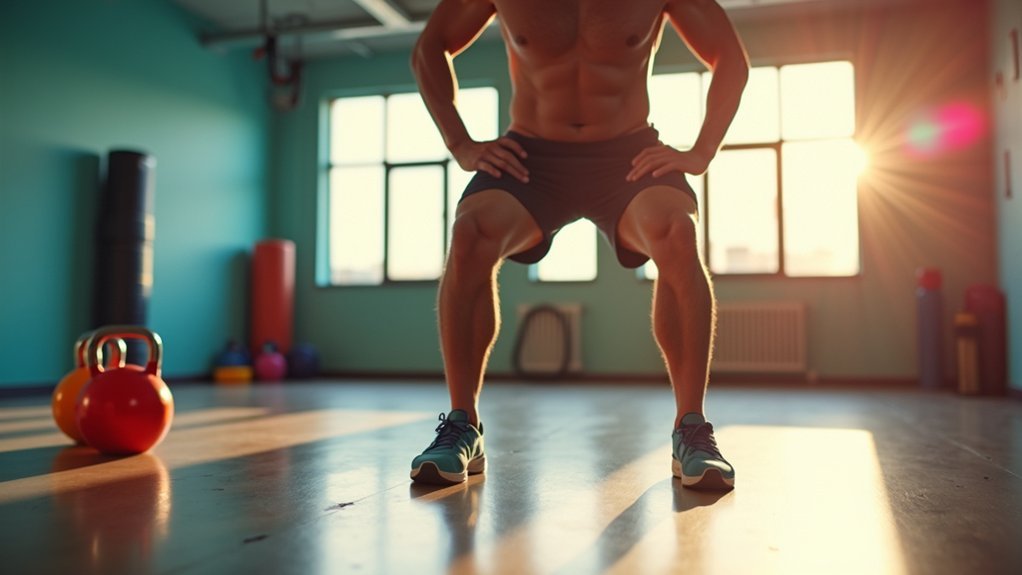HIIT workouts powerfully stimulate your lymphatic system through muscle contractions that pump lymph fluid. Try these five effective moves: jumping jack intervals (30 seconds on, 15 seconds rest), high knee sprints, rebounding mountain climbers on a mini-trampoline, burpees, and squat jumps. Remember to incorporate proper rest periods between exercises and stay hydrated throughout. These dynamic exercises not only boost detoxification but also improve overall cardiovascular fitness. Discover how these specific movements transform your body’s natural cleansing processes.
The Science Behind HIIT and Lymphatic Circulation

While many people associate HIIT with burning calories and building cardiovascular fitness, this training method also works wonders for your lymphatic system.
Unlike your blood, which has a heart to pump it, lymph fluid relies entirely on muscle contractions to move through your body.
During HIIT workouts, you’re engaging multiple muscle groups through intense bursts followed by recovery periods. This creates a powerful pumping action that propels lymph through vessels, removing toxins and reducing inflammation.
When you come back to each high-intensity interval, your increased heart rate stimulates greater lymphatic circulation.
The alternating intensity pattern of HIIT is particularly effective because it combines the benefits of vigorous exercise with strategic recovery, optimizing oxygen consumption and metabolic activity that supports your body’s natural detoxification processes.
Jumping Jack Intervals: Boosting Full-Body Lymph Flow
Because they engage multiple muscle groups simultaneously, jumping jacks serve as one of the most effective exercises for stimulating lymphatic circulation throughout your entire body.
This dynamic movement creates a pumping action that helps move lymph fluid efficiently, reducing swelling and improving overall circulation.
Try performing jumping jacks in 30-second bursts followed by 15-second rest periods. This interval approach maximizes cardiovascular benefits while giving your lower body just enough recovery time.
You’ll not only burn calories and boost metabolism but also greatly enhance your lymphatic drainage system.
For those with mobility concerns, modify the exercise by stepping out instead of jumping, while still moving your arms overhead.
Even this adapted version delivers impressive benefits for your lymphatic system while improving coordination and agility.
High Knee Sprints: Activating Lower Extremity Drainage

High knee sprints serve as a powerhouse movement for stimulating lymphatic drainage in your legs, hips, and lower abdomen. By rapidly lifting your knees toward your chest, you’re activating the muscle pump action that propels lymph fluid through your system, reducing swelling and fluid retention.
Try incorporating this dynamic exercise into your routine with these simple steps:
- Perform 30-60 second intervals of high knees to elevate your heart rate and enhance lymphatic flow.
- If high-impact movements aren’t suitable, switch to controlled high knee marches every day for similar benefits.
- Focus on proper form by maintaining an upright posture while driving your knees upward to guarantee ideal lower extremity drainage.
This efficient HIIT move simultaneously improves cardiovascular fitness, coordination, and lower body strength—all essential for healthy lymphatic function.
Rebounding Mountain Climbers for Enhanced Detoxification
Unlike traditional mountain climbers, the rebounding version transforms this classic exercise into a lymphatic powerhouse. When you perform this move on a mini-trampoline, you’re engaging multiple muscle groups while stimulating your lymphatic system without stressing your joints.
The bounce factor creates a rhythmic pumping effect that accelerates detoxification through increased circulation and lymph flow. You’ll find yourself working out longer thanks to the fun, bouncy nature of this exercise.
| Benefit | Muscle Groups | Lymphatic Effect |
|---|---|---|
| Low impact | Core, shoulders | Prevents fluid stagnation |
| Enhanced circulation | Quadriceps, hamstrings | Promotes detoxification |
| Reduced joint stress | Arms, chest | Improves lymph flow |
| Increased endurance | Glutes, calves | Reduces lymphedema symptoms |
| Full-body workout | Abdominals, hip flexors | Accelerates waste removal |
For lymphedema sufferers, this exercise is particularly valuable as it encourages healthy fluid movement throughout the body.
Incorporating Rest and Recovery for Optimal Lymphatic Benefits

While HIIT exercises effectively stimulate lymphatic flow, your body’s cleansing system requires strategic downtime to function at its peak. Alternating between high-intensity workouts and rest days prevents overexertion and reduces lymphedema flare-up risks.
Your recovery routine should include:
- Active recovery sessions – Incorporate gentle walking or stretching after intense HIIT workouts to enhance circulation and promote lymphatic drainage.
- Consistent hydration – Drink water throughout your exercise and recovery periods to support lymphatic fluid balance.
- Body awareness practice – Listen to your physical cues and adjust rest periods accordingly; proper recovery improves both exercise performance and lymphatic efficiency.
Frequently Asked Questions
What Is the Best Exercise for Lymphatic Drainage?
You’ll benefit most from regular walking, rebounding, yoga, and deep breathing exercises. They’re low-impact activities that effectively stimulate your lymphatic system, promoting fluid movement and drainage without straining your body.
How Do You Bounce for Lymphatic Drainage?
To bounce for lymphatic drainage, stand with feet hip-width apart, gently rise onto the balls of your feet and drop back down rhythmically. Start with 5-10 minutes daily, breathing deeply throughout the exercise.
What Form of HIIT Is Most Effective?
The most effective HIIT form combines 20-40 second intense bursts with equal rest periods. You’ll see best results incorporating lower body movements like squats and lunges that stimulate lymphatic circulation while engaging multiple muscle groups.
How Do You Increase Lymphatic Flow?
You’ll increase lymphatic flow by exercising regularly, especially with leg and core movements, practicing deep breathing techniques, staying well-hydrated, and elevating your legs after activity. These habits create pressure changes that promote circulation.
In Summary
You’ve now got five powerful HIIT moves to enhance your lymphatic system’s flow. By incorporating these dynamic exercises into your routine, you’ll boost circulation, support detoxification, and improve overall wellness. Remember to balance intensity with proper recovery—your lymphatic system needs both to function effectively. Start with just 10-15 minutes twice weekly and you’ll soon feel the energizing benefits of better lymphatic health.





Leave a Reply